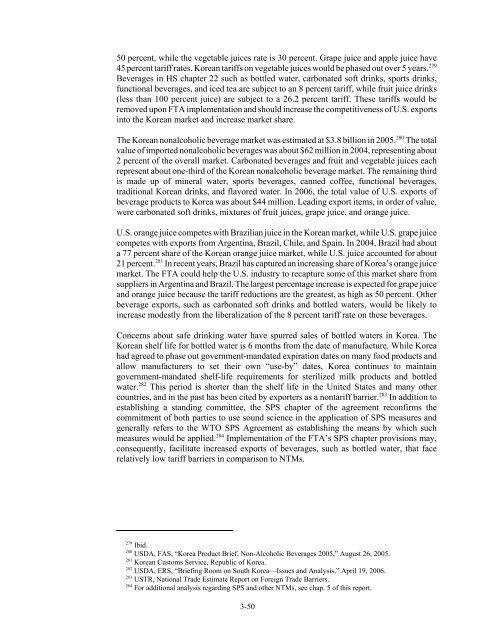U.S.-Korea Free Trade Agreement: Potential Economy-wide ... - USITC
U.S.-Korea Free Trade Agreement: Potential Economy-wide ... - USITC
U.S.-Korea Free Trade Agreement: Potential Economy-wide ... - USITC
Create successful ePaper yourself
Turn your PDF publications into a flip-book with our unique Google optimized e-Paper software.
50 percent, while the vegetable juices rate is 30 percent. Grape juice and apple juice have<br />
45 percent tariff rates. <strong>Korea</strong>n tariffs on vegetable juices would be phased out over 5 years. 279<br />
Beverages in HS chapter 22 such as bottled water, carbonated soft drinks, sports drinks,<br />
functional beverages, and iced tea are subject to an 8 percent tariff, while fruit juice drinks<br />
(less than 100 percent juice) are subject to a 26.2 percent tariff. These tariffs would be<br />
removed upon FTA implementation and should increase the competitiveness of U.S. exports<br />
into the <strong>Korea</strong>n market and increase market share.<br />
The <strong>Korea</strong>n nonalcoholic beverage market was estimated at $3.8 billion in 2005. 280 The total<br />
value of imported nonalcoholic beverages was about $62 million in 2004, representing about<br />
2 percent of the overall market. Carbonated beverages and fruit and vegetable juices each<br />
represent about one-third of the <strong>Korea</strong>n nonalcoholic beverage market. The remaining third<br />
is made up of mineral water, sports beverages, canned coffee, functional beverages,<br />
traditional <strong>Korea</strong>n drinks, and flavored water. In 2006, the total value of U.S. exports of<br />
beverage products to <strong>Korea</strong> was about $44 million. Leading export items, in order of value,<br />
were carbonated soft drinks, mixtures of fruit juices, grape juice, and orange juice.<br />
U.S. orange juice competes with Brazilian juice in the <strong>Korea</strong>n market, while U.S. grape juice<br />
competes with exports from Argentina, Brazil, Chile, and Spain. In 2004, Brazil had about<br />
a 77 percent share of the <strong>Korea</strong>n orange juice market, while U.S. juice accounted for about<br />
21 percent. 281 In recent years, Brazil has captured an increasing share of <strong>Korea</strong>’s orange juice<br />
market. The FTA could help the U.S. industry to recapture some of this market share from<br />
suppliers in Argentina and Brazil. The largest percentage increase is expected for grape juice<br />
and orange juice because the tariff reductions are the greatest, as high as 50 percent. Other<br />
beverage exports, such as carbonated soft drinks and bottled waters, would be likely to<br />
increase modestly from the liberalization of the 8 percent tariff rate on these beverages.<br />
Concerns about safe drinking water have spurred sales of bottled waters in <strong>Korea</strong>. The<br />
<strong>Korea</strong>n shelf life for bottled water is 6 months from the date of manufacture. While <strong>Korea</strong><br />
had agreed to phase out government-mandated expiration dates on many food products and<br />
allow manufacturers to set their own “use-by” dates, <strong>Korea</strong> continues to maintain<br />
government-mandated shelf-life requirements for sterilized milk products and bottled<br />
water. 282 This period is shorter than the shelf life in the United States and many other<br />
countries, and in the past has been cited by exporters as a nontariff barrier. 283 In addition to<br />
establishing a standing committee, the SPS chapter of the agreement reconfirms the<br />
commitment of both parties to use sound science in the application of SPS measures and<br />
generally refers to the WTO SPS <strong>Agreement</strong> as establishing the means by which such<br />
measures would be applied. 284 Implementation of the FTA’s SPS chapter provisions may,<br />
consequently, facilitate increased exports of beverages, such as bottled water, that face<br />
relatively low tariff barriers in comparison to NTMs.<br />
279 Ibid.<br />
280 USDA, FAS, “<strong>Korea</strong> Product Brief, Non-Alcoholic Beverages 2005,” August 26, 2005.<br />
281 <strong>Korea</strong>n Customs Service, Republic of <strong>Korea</strong>.<br />
282 USDA, ERS, “Briefing Room on South <strong>Korea</strong>—Issues and Analysis,” April 19, 2006.<br />
283 USTR, National <strong>Trade</strong> Estimate Report on Foreign <strong>Trade</strong> Barriers.<br />
284 For additional analysis regarding SPS and other NTMs, see chap. 5 of this report.<br />
3-50

















